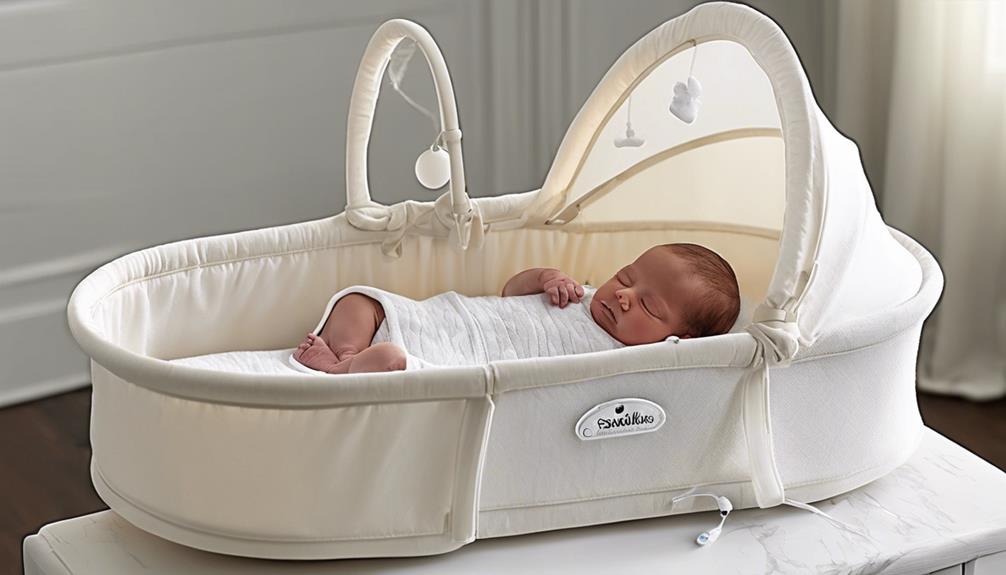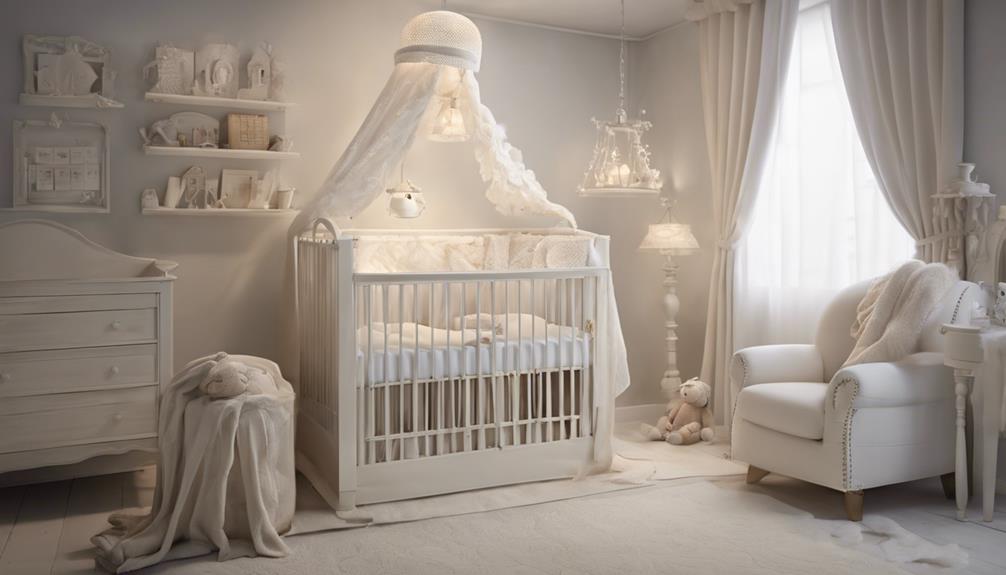When it comes to getting your newborn to sleep in the bassinet, it can feel like sailing through a maze of uncertainty. Just like a gentle breeze guiding a paper boat, there are ways to help your little one find peaceful slumber in their cozy nest.
However, with our expert tips and proven methods at your disposal, you'll soon discover the key to revealing those elusive moments of rest. Let's untangle the mysteries of soothing your newborn to sleep in the bassinet and set the stage for tranquil nights ahead.
Key Takeaways
- Position your newborn on their back for safe sleep and reduce SIDS risk.
- Establish a consistent bedtime routine with calming activities for better sleep.
- Ensure regular and adequate daytime feeds to prevent hunger-related sleep disturbances.
- Create a cozy sleep environment with scent association, proper temperature, and soothing touch techniques.
Establish a Safe Sleep Environment
To guarantee a safe sleep environment for your newborn in the bassinet, it's vital to use a firm mattress and fitted sheet while positioning them on their back to reduce the risk of SIDS. Your baby's safety during sleep is our top priority. Placing your little one on their back is important for their well-being. This simple step greatly lowers the chances of SIDS, giving you peace of mind as your baby slumbers peacefully.
Loose bedding, pillows, or soft toys should be kept out of the bassinet to avoid any suffocation hazards. We also recommend ensuring proper ventilation in the room where the bassinet is placed to maintain a comfortable temperature for your newborn. By following these guidelines, you create a secure and cozy sleep haven for your precious bundle of joy.
Your baby's safety is paramount, and we're here to guide you in providing the best sleep environment for them.
Implement a Bedtime Routine

Let's talk about setting up a bedtime routine for your newborn.
Establishing a consistent routine can help create a sense of predictability and calm before sleep.
Routine for Bedtime
Establishing a consistent bedtime routine signals to your newborn that it's time to sleep. For a soothing bedtime experience, try incorporating calming activities like a warm bath, gentle massage, or a quiet story before bedtime. Utilize soothing techniques such as dimming lights and playing soft music to create a relaxing environment conducive to sleep. Avoid stimulating activities or screen time close to bedtime as these can hinder your newborn's ability to wind down. By sticking to the bedtime routine every night, you are providing a predictable and comforting sleep environment for your little one. Consistency is key in helping your newborn establish healthy sleep patterns.
| Calming Activities | Soothing Techniques |
|---|---|
| Warm bath | Dimming lights |
| Gentle massage | Soft music |
| Quiet story |
Consistent Sleep Environment
Creating a consistent bedtime routine is essential for helping your newborn understand when it's time to sleep in the bassinet. To establish a soothing environment, consider the following:
- Start with a warm bath to relax your baby.
- Follow up with a gentle massage to calm and comfort them.
- Engage in reading a story to create a tranquil atmosphere.
- Dim the lights gradually to signal that it's time to wind down.
Calming Activities Before Bed
To help your newborn settle for sleep in the bassinet, engaging in calming activities before bedtime can set the stage for a peaceful switch to rest. Implementing a bedtime routine with soothing activities like gentle rocking or lullabies can signal to your baby that it's time to wind down.
Create a relaxing environment by using dim lighting and soft voices during this routine. Avoid stimulating activities or screens close to bedtime, as these can hinder the settling process. Establishing a predictable sequence of events before slumber can help your baby recognize cues for bedtime, making the change smoother.
Encourage Daytime Naps

Encouraging your newborn to take daytime naps is essential for their overall well-being and development. To help your little one get the rest they need, consider the following tips:
- Establish a Nap Routine: Creating a consistent schedule for naps can help regulate your newborn's sleep-wake cycle and make it easier for them to fall asleep during the day.
- Provide a Quiet Environment: Setting up a peaceful space with minimal noise and dim lighting can create an ideal nap environment for your baby.
- Watch for Awake Windows: Pay attention to your newborn's cues for sleep readiness, such as rubbing their eyes or becoming fussy, to catch the right moment for a nap.
- Prevent Overtiredness: Encouraging short naps throughout the day can help prevent your baby from becoming overtired, which can make it harder for them to settle down for sleep.
- Follow Sleep Cues: By observing your newborn's signals of tiredness and readiness for sleep, you can improve their chances of successful daytime naps.
Maximize Daytime Feeds

Establishing a routine for daytime feeds is crucial to ensuring your newborn gets the nourishment required to support healthy sleep patterns. It's essential to keep your little one well-fed during the day to prevent hunger-related sleep disturbances at night. By aiming for consistent and adequate daytime feeds, you can establish a healthy feeding routine that promotes better sleep patterns.
Maximize daytime feeds to encourage longer stretches of sleep at night, reducing the need for frequent nighttime feedings. Consider implementing cluster feeding in the evening to top up your newborn's intake and help them sleep longer. Offering breast or bottle feeds at regular intervals throughout the day not only supports your newborn's growth and development but also aids in sleep regulation.
Use Scent Association

Infuse your newborn's bassinet with your comforting scent to create a familiar and secure sleep environment for them. Your scent can work wonders in soothing your baby and helping them feel safe and protected while they rest.
Here are some ways scent association can help your baby sleep better in the bassinet:
- Transfer Your Scent: Apply your scent to the bassinet sheet to make it a cozy spot that smells like you.
- Regular Reapplication: Keep the comforting scent fresh by reapplying it regularly so that the association with security stays strong.
- Mimic Familiarity: Surround your baby with your scent to replicate the feeling of being close to you, promoting comfort and relaxation.
- Emotional Connection: Using your scent fosters an emotional bond with your baby, enhancing their peaceful sleep environment.
- Enhance Security: Your familiar scent creates a cozy and inviting atmosphere in the bassinet, helping your baby feel secure and ready for a restful sleep.
Maintain Comfortable Temperature

Let's make sure the room is just right for your little one's sleep. Keeping the temperature between 68-72 degrees Fahrenheit creates a cozy environment.
Dressing your baby in light layers and avoiding heavy blankets will help them rest comfortably.
Temperature Control Tips
Maintaining a comfortable temperature in the room is essential for ensuring your newborn's best sleep conditions in the bassinet. Here are some temperature control tips to help create an ideal sleep environment:
- Maintain room temperature: Keep it between 16-20 degrees Celsius for the best sleep conditions.
- Dress appropriately: Make sure your baby is dressed according to the room temperature for comfort.
- Consider swaddling: If your baby isn't rolling over, swaddling can provide warmth and security.
- Feed before sleep: Regulate body temperature and promote relaxation by feeding your baby before sleep.
- Create a soothing environment: Settle your baby in a dark room with white noise to encourage peaceful sleep in the bassinet.
Ideal Sleep Environment
To guarantee your newborn gets the best sleep in the bassinet, maintaining a comfortable temperature in the room is essential. Aim for a temperature between 68-72 degrees Fahrenheit to create ideal sleep conditions. Using a thermometer can help you make sure the room is just right for your baby.
Be cautious not to let the room get too hot or too cold, as extreme temperatures can disrupt your baby's sleep. Dress your newborn in light, breathable clothing suitable for the room temperature to help them stay comfortable.
Manage Lighting Conditions

Creating a soothing environment with dim lighting or darkness can help your newborn settle in the bassinet for a restful sleep. When managing lighting conditions for your baby, consider the following tips:
- Keep the room dark or use dim lighting: Signal sleep time and create a calming environment for your newborn.
- Avoid bright lights or screens: They can stimulate your baby and make it harder for them to settle in the bassinet.
- Consider blackout curtains or shades: Block out external light to maintain a dark sleep space for your newborn.
- Use soft, indirect lighting like a nightlight: Provide a gentle glow for nighttime feedings or diaper changes without disrupting your baby's sleep.
- Maintain consistent lighting conditions: This can help regulate your newborn's circadian rhythm and promote better sleep patterns in the bassinet.
Incorporate Soothing Touch

Let's talk about how we can incorporate soothing touch to help our newborns sleep better in the bassinet.
By gently massaging their back or head, we can provide comfort and relaxation, making the change to the bassinet smoother.
Additionally, cuddling moments and soft swaddling techniques can create a cozy and secure environment that encourages peaceful sleep for our little ones.
Gentle Massage Techniques
Using gentle massage techniques is a soothing way to relax your newborn before bedtime. It can help create a calming atmosphere, signaling that it's time to wind down for sleep. Here are some tips for incorporating baby massage into your bedtime routine:
- Use light, circular motions: Gentle strokes on your baby's back or limbs can promote relaxation.
- Establish a routine: Consistent massages before sleep can become a comforting part of your baby's bedtime routine.
- Promote bonding: Massage releases oxytocin, aiding in bonding during bedtime rituals.
- Create a peaceful environment: Dim the lights, play soft music, and create a relaxing atmosphere.
- Observe your baby's cues: Pay attention to your baby's responses to find what techniques work best for them.
Calm Cuddling Moments
To continue fostering a sense of peace and connection with your newborn, incorporating calming cuddling moments can enhance the soothing environment needed for a restful sleep in the bassinet. Cuddling helps soothe your newborn, providing comfort and security essential for a peaceful slumber.
The gentle touch and warmth during cuddling can reassure your little one, making the shift to the bassinet smoother. Skin-to-skin contact promotes bonding and relaxation, aiding in creating a serene atmosphere conducive to sleep.
Soft Swaddling Comfort
Incorporating soothing touch while swaddling your newborn in the bassinet can help create a sense of security and warmth, enhancing their sleep experience. Soft swaddling provides a snug and secure feeling for newborns, mimicking the womb environment. Here are some key points to think about for soft swaddling comfort:
- Using a lightweight, breathable swaddle can prevent overheating and guarantee comfort during sleep.
- Swaddling helps reduce the startle reflex in newborns, promoting longer and more restful sleep in the bassinet.
- Incorporating soothing touch while swaddling, such as gentle strokes or pats, can further calm and relax the baby for sleep.
- Soft swaddling techniques can create a sense of security and warmth, enhancing the newborn's sleep experience in the bassinet.
Utilize Sound Machines

When soothing your newborn to sleep in the bassinet, consider incorporating a sound machine to create a womb-like environment that promotes uninterrupted rest. Sound machines emit white noise that mimics the comforting sounds babies experience in the womb, helping them relax and feel secure in their sleeping space. This consistent sound can also mask external noises, ensuring your little one isn't easily disturbed during naps or nighttime sleep.
Here is a table highlighting the benefits of utilizing a sound machine for your newborn's sleep routine:
| Benefits of Using a Sound Machine |
|---|
| Creates a womb-like environment |
| Masks external noises |
| Enhances baby's comfort |
Practice Drowsy but Awake Technique

Practicing the drowsy but awake technique with your newborn in the bassinet can help foster independent sleep habits and encourage self-soothing abilities. This method can assist your baby in learning to fall asleep independently, establishing healthy sleep associations with the bassinet, and reducing reliance on external sleep aids like rocking or nursing to sleep.
By starting this technique early, you can set the stage for good sleep habits and promote longer stretches of sleep for your little one. Here's how to incorporate the drowsy but awake technique effectively:
- Place your baby in the bassinet when they're drowsy but not fully asleep.
- Allow them the opportunity to self-soothe and drift off to sleep independently.
- Consistently practice this technique to help your baby build healthy sleep associations.
- Avoid using external sleep aids to assist your baby in falling asleep.
- Establishing this routine early on can lead to longer periods of uninterrupted sleep for your baby.
Conclusion
To sum up, getting your newborn to sleep in the bassinet may feel like trying to tame a wild tiger, but with patience and consistency, you can create a peaceful sleep haven for your little one.
By following these 10 strategies, you can help your baby feel safe and secure in their sleeping space, allowing for better sleep for everyone involved.
Remember, Rome wasn't built in a day, so don't expect instant success – but keep at it, and you'll see progress!










